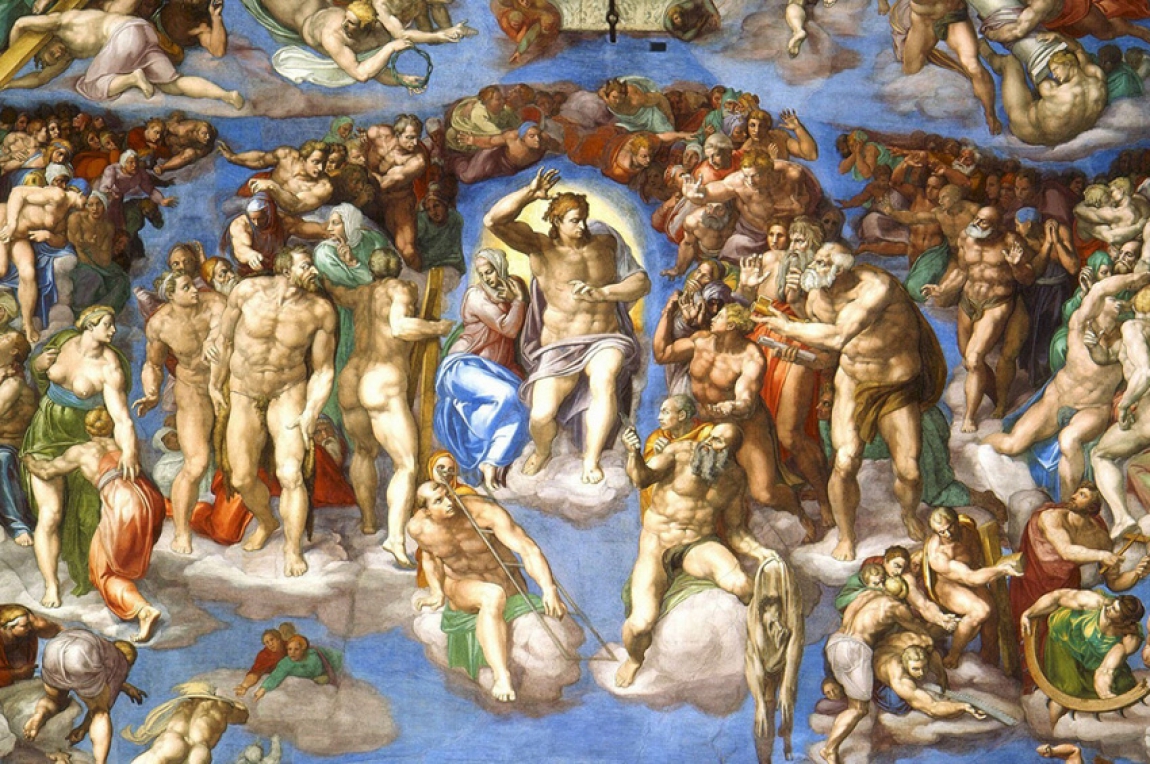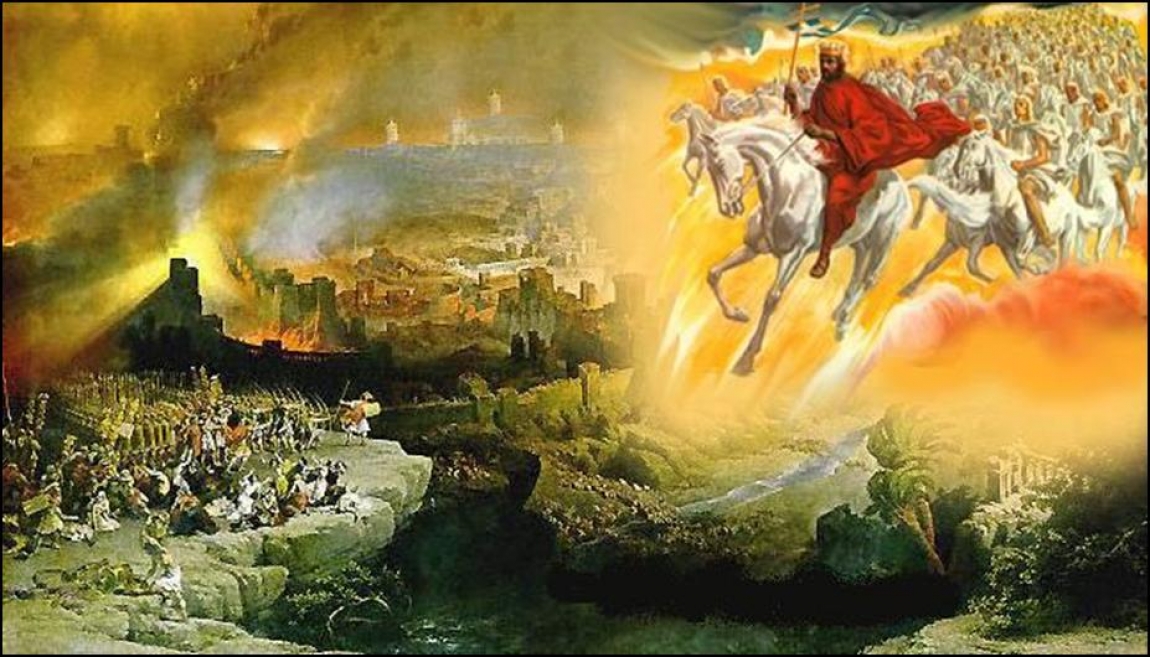The End of Times
Since May 1948 we have been living in what is biblically known as the “End Times”, which is not the end of the world, but rather the end of the present times, which Saint Paul calls the “ Time of the nations” or “Of the gentiles”, which began when the old Mosaic times finished, once the Jews rejected the Messiah. Because they had killed Christ, God turned to the gentiles to invite them to enter His church, and became silent regarding His chosen people.
The present times will end: the time of the church will draw to a close once the last gentile has entered and God will then concentrate once again on Israel. Saint Paul expresses it like this: “The partial hardening which overcame Israel will last until the totality of the gentiles enter... “(Rom 11, 26).
On the 15th of May 1948 when the Jews returned to the Promised Land almost sixty prophecies were fulfilled and this event marks the beginning of a special time which prepares humanity for the return of the Messiah.
What remains is only the final part of the End Times in which we are already living, and in which the seven years of the “Great Tribulation” will take place, as described by the Prophet Daniel and Saint John. This period starts with the war of Gog and Magog, in which Russia and Arab countries will attack Israel (Ez. 38, 3-8).
Millenniarism
To summarise it quickly, the question consists of a discrepancy between two visions regarding general eschatology. The first known as “Millenniarist” or “Millenniasist” maintains the Christ will return for the second time in His Parousia, at the end of the Great Tribulation, to judge the nations and establish His Kingdom in the world. According to Saint John, this Kingdom will last a “Thousand years” (Apoc. 20, 2-3) from where it gets the name “Millenniarism”, as it could be a thousand physical years or metaphorically speaking , “A long period”: “A thousand years in your presence are like yesterday that has passed”. At the end of this Kingdom of Christ in the world, described in an admirable way by Isiah, then the end of the world will come and universal judgement.
The second eschatological school maintains that there will not be an intermediate coming of Christ nor an intermediate Kingdom, but that the Parousia will not happen until the end of the world, thus coinciding with the Universal Judgement.
The first theological opinion was held by all the first fathers of the church, including the young Saint Augustine. The other theological opinion from the older Saint Augustine onwards was held by the majority of theologians. This change in the Bishop of Hipona was due to a contemporary heretic of his called Cerinth, who taught that the Kingdom of Christ on earth had to do with material wellbeing, feasts, eating and riches. Saint Augustine confronted him in his book “The city of God”. The problem was that Augustine spiritualised the Kingdom in such an exaggerated way that he confused it with heaven, and the return of Christ with the Universal Judgement. The doctrine of Cerinth is known as “crass” or “carnal” millenniarism, because of the materialism it contains.
From the point of view of the Magisterium of the Catholic Church we find ourselves with the typical case where there is theological freedom. In other words, we are not bound by faith to profess the time the Parousia will happen, and we are free to choose if it will happen in the “End Times” i.e. in the present time, after the Great Tribulation (A literal symbolic or millenniarist interpretation), or we can also believe it will happen at the “End of the world”, coinciding with the Universal Judgement (Allegorical interpretation).
Only a definition of the Magisterium exists regarding the subject of Millenniarism and it is the decree of the 21th of July 1944 of Pope Pius XII (It appears in Denzinger no. 2296 and later developed in no. 3839). This decree establishes that if one believes the thesis of the Kingdom as an historical occurrence, fruit of the intermediate coming of Christ, you can’t believe the idea that Christ will reign “visibly” (“visibiliter”) in this world after the Parousia. The proposition that Christ continue to reign here after His Parousia is known as “mitigated” millenniarism, and is sanctioned by the Magisterium, albeit with the lowest theological classification, that of a “dangerous teaching” which falls short of a condemnation. The best advice is not to follow this mitigated millenniarism.
Along the same lines, the instruction of the Sacred Congregation for the Doctrine of the Faith of the 17th of May 1979 is of great importance «Letter on some questions referring to Eschatology », approved by John Paul II (cf. L’Osservatore Romano No. 29 (551) of the 22nd of July 1979, page 12).
Relating to the Parousia, he teaches the following: «The Church, conforming to Sacred Scripture, waits for “the glorious manifestation of Jesus Christ our Lord” (Dei Verbum 1, 4), considered moreover, as distinct and postponed with respect to the condition of men immediately after death».
This means that as regards the content of the faith, the Parousia has no ties with the End of the World, but is tied, typologically, with the personal death of each one. In other words, the Magisterium prescribes that this eschatological fact be considered as related to personal death and deferred in time. But nothing else.
The instruction does not say if the Parousia will coincide with the Last Judgement or relate to an intermediate coming. Because the postponement in relation to the individual death exists both with the Parousia together with the judgement of the nations, as the Parousia together with the Last Judgement. It is different.
This document is very important because of its dogmatic content, but it has other important exegetical consequences by confirming implicitly that one can believe either opinion, thus confirming the non pronouncement of the church, i.e. its neutrality, already evident in the Decree of 1944.
Finally, with maximum authority, the Catechism of the Catholic Church in no. 676 ratifies the Decree of 1944, because by mentioning the rejection of Millenniarism in its “mitigated” form, it refers to «DS 3839».
Let it be noted that it is the first version of the Catechism of the Church that deals with Millenniarism. It is not mentioned in previous versions.
No. 676 ratifies it once again, sufficiently for this topic. In effect, by referring to DS 3839 and therefore to the Decree of 1944, it ratifies “mitigated” millenniarism as the only excluded form of millenniarism, while freedom of opinion is given to millenniarism in general. Nevertheless, the Holy Father, contemplating those weak in the faith as St. Paul did, - i.e. the most obstinate antimillenniarists- takes advantage of this weakness to combat the most dangerous error that has infiltrated the church, the desacralized and «intrinsically perverse» millenniarism of Marxism and Communism, but without rejecting other forms of millenniarism, not designated or defined as «mitigated». The “intrinsically perverse” is political millenniarism, which we must clearly reject.
By referring to DS 3839, No. 676 of the Catechism of the Catholic Church, after referring to the “deception of the antichrist” says that even in its mitigated form, the church has rejected this falsification of the future kingdom with the name of millenniarism, especially in the form of an «intrinsically perverse» secularised messianism (See also the Encyclical Divini Redemptoris of Pius XII, which condemns “the false mysticism” of this “falsification of the redemption of the humble” (GS 20-21).
Of course, this account only supports what was said already that the Catechism takes advantage of the opportunity to combat the desacralized and «intrinsically perverse» millenniarism of Marxism and Communism. But the fact is that, according to DS and the Decree of 1944, «mitigated» millenniarism does not constitute «error» but simply «danger of error». Careful: at the same time that it quotes DS 3839, No. 676 of the CCC refers to mitigated millenniarism as the «falsification of the future kingdom», i.e. as a grave error.
The contradiction is only apparent. In fact, to sustain that Christ will reign «visibly» during His millennial reign on earth is not certain, it is doubtful and does involve «danger of error» which is why to reject it is the best advice. But strictly speaking, this danger of error may or may not materialise.
For example, it is not certain but doubtful, but it would not seem clearly erroneous to sustain, as various exegetes do, that in His millennial reign on earth, Christ will reign making Himself intermittently «visible» to some people, appearing and disappearing as happened between the Resurrection and the Ascension, or as he does at the present with certain mystics and seers.
To maintain, on the other hand, that in the millennial reign, Christ will be permanently «visible», reigning over those of the first resurrection and the raptured, in an era that «floats between time and eternity» constitutes error without any doubt or more precisely a series of errors against the faith.
It is necessary to point out, however, that the Decree of 1944 (and also its antecedent of 1941) says «be it with the previous resurrection of many of the just or without it». In other words, it does not make a pronouncement about the first resurrection and the rapture, it considers them somewhat indifferent to the topic in question, and it leaves it up to individual opinion.
The promise of Our Lord that the raptured and those raised from the dead in the first resurrection, particularly the apostles, will sit on thrones, judge and reign with Christ a «thousand years» over the «twelve tribes of Israel», i.e. over the converted Israel, the transformed church and over all humanity (as revealed to us in Apoc. 20, 4 and 6; Mt. 19, 28; LK. 22, 30) hangs over all these problems. Today, the apostles enjoy the beatific vision but they are not reigning yet. To do that they must rise from the dead. Why? Because only the souls of the apostles and saints are in the beatific vision, while to reign (to administer justice, rule the nations with justice, etc. in the words of Isiah and other prophets) is proper to men of body and soul. Souls intercede but do not govern; they will be able to do it when, in the first resurrection and the rapture of the saints, the soul unites with the body.
The topic of the millenary reign of Christ can raise questions that are difficult to understand, especially if one does not study it, but fortunately in previous decades, a group of catholic exegetes, without knowing each other, among whom the religious Antonio van Rixtel stands out(no doubt inspired by the Jesuit Manuel Lacunza), and others, managed to explain what had remained obscured in theology, namely: how Christ with the raptured and those raised from the dead in the first resurrection would reign on earth, without living with or alternating with ordinary mortals and how the full “kingdom of Christ “ will be intra-historical (different from heaven), a new age where purified humanity will continue being tested but greatly helped both supernaturally and naturally by grace and the Pauline transformation, this «Civilisation of Love and Peace» preached by Paul VI, John Paul II and Benedict XVI where there will be «only one flock and one shepherd». A highly recommended text which has all the theological evolution and the different postures of the Popes is: Antonio van Rixtel «el Testimonio de nuestra Esperanza» (Witness of our Hope) in «Third Millennium – The mystery of the Apocalypse», Ed. «Gladius» Buenos Aires, 1995. And, of course, the great text that produced every revolution in modern theology: La Venida del Mesias en Gloria y Majestad (The coming of the Messiah in Glory and majesty) by Jesuit theologian Manuel Lacunza.
Finally, it is necessary to point out that «visibly» can be translated by still more serious errors, by «mitigated» millenniarism which clearly implies the worse «Falsification of the Future Kingdom» among which modern «mitigated» millenniarism of present sects coming from the Reform may be cited. It is to this type of errors that the Catechism of the Catholic Church No. 676 specifically refers, even if it prefers to concentrate on the most dangerous of all the errors, in « secularised messianism, “intrinsically perverse”» of Marxism and Communism.
Following Van Rixtel, Cámpora, Alfredo Saenz and other experts, we must highlight that No. 677 of the CCC rejects «non interventionism» (an extreme form of the allegorical interpretation) because it maintains that «the reign will not come to be, therefore, by way of the historical triumph of the church in the form of an increasing process but rather by God’s victory over the ultimate unleashing of evil»
No. 677 is interpreted as a rejection of millenniarism because it speaks of the «ultimate unleashing of evil» and because it says that «the triumph of God over the rebellion of evil will take the form of the final judgement (See Apoc. 20, 12), after the last cosmic shaking of this world which is passing away (2 Pet. 3, 12-13). Nevertheless, this number may also be given a millenniarist spiritual interpretation, as it starts by saying that «The church will enter into the glory of the kingdom by way of the final Passover in which it will follow its Lord in His death and resurrection (see Apoc. 19, 1-9) ». The “final Passover” is the Passover of the church, which, following its Lord, will suffer a mystical death under the antichrist and the False Prophet during the Great Tribulation, the «cessation of the perpetual sacrifice» and the «abomination of desolation in the holy place». Afterwards, it will experience the resurrection, also mystical, by way of the resurrection of the martyrs and the rapture of the saints described by Saint Paul and Saint Matthew (1 Cor. 15, 51; 1 Thess. 4, 16-17; Mt. 24, 37- 40).
«The glory of the kingdom» is as much that of the celestial kingdom as that of the millenary kingdom of Christ on earth. It’s the glory of the kingdom wherein the church triumphant, the resurrected apostles of the first resurrection, sitting in the celestial Jerusalem of twelve thrones, will judge «the twelve tribes of Israel» and all humanity (see Apoc. 20, 4; Mt. 19, 28).
The glory of the celestial kingdom is also the glory of the millenary kingdom of Christ, where the church militant (consult St. Bonaventure, «the seventh time, when the militant conforms to the triumphant as much as possible in this world») will be renewed and glorified by the New Pentecost, embracing all humanity which will live the «civilisation of love and peace» in «one fold and one shepherd». It will be when «a victory of God over the final unleashing of evil» makes the church triumphant «descend from heaven to its spouse». The raptured and those resurrected in the first resurrection will be united to it and descend with the glorious Christ in His Parousia (Acts 1, 10- 11). But this does not mean that Christ will visibly reign in His kingdom, a fact which is not correct to teach.
By «the final unchaining of evil» we may understand not only that of Gog and Magog (Ex. 38, 3-8), but more appropriately that of the «satanic trio» (Satan, the «beast of the sea» or “antichrist” and the «beast from the land» or “false prophet” because this will be when the church will suffer its mystical death.
For this reason, «The triumph of God over the rebellion of evil will take the form of a final judgement (Apoc. 20, 12), after the final cosmic shaking of this world which is passing away (2 Pet. 3, 12-13), allows only one interpretation, because it is an undoubtable reference of this whole eschatological event. It is fitting to point out that this rebellion refers to all the evil from the beginning, from the rebellion of the angels and original sin, while the latter are precipitated in an extreme form.
Sometimes people object that the Catechism of the Catholic Church cannot contradict itself and that understanding No. 676 in the sense that it consecrates the neutrality of the 1944 Decree means that it contradicts other eschatological numbers of the same Catechism. However, it is not at all like that because we must remember that these numbers refer to various eschatological themes different from the Parousia, the intra-historical and physical return of Christ and the kingdom of Christ. They refer to the «final judgment»; to the celestial kingdom; to the «end of the world», to the true and proper sense of the end of humanity on earth; to the General Resurrection, etc. But there are other passages that do refer to the Parousia and to the kingdom of Christ, and these can be interpreted both with an allegorical interpretation as with a literal- symbolical or millenniarist interpretation.
Consequently, it is confirmed that the Catechism does not favour either one of the two interpretative currents, neither the allegorical nor the literal -symbolical or millenniarist. Nevertheless, it does reject the extreme position of each of them, the «mitigated» (because of «visibly») in number 676 and the «non- interventionist» in No. 677.
Summarising, the Magisterium of the church allows free interpretation of the problem of the kingdom of Christ and it frames it by getting rid of two extremes: from the side of spiritual millenniarism, the «visibly», on the contrary, i.e. on the side of allegory, No. 677 of the Catechism of the church rules out that this kingdom establishes itself «by way of the historical triumph of the church (Apoc. 13, 8) in the form of a growing process», i.e. without an extraordinary divine intervention, after the apparent triumph of evil during the Great Tribulation.
Notwithstanding this freedom, the spiritual millennial model is more harmonious with Scriptures and was maintained by nearly all the church fathers, while the anti- millennial model has internal contradictions and leaves many things unexplained.
The Parousia, as the physical and intermediary return of Christ, which according to St. John will happen in the valley of Armageddon at the end of the Great Tribulation, seems more in agreement with Scriptures while an intermediary “spiritual” or metaphorical coming has no basis and creates a lot of confusion: “After the Tribulation of those days, they will see the Son of man coming on the clouds of heaven with great power and glory” (Mt. 24, 29; Mk. 13, 26; Lk. 21, 27).
The angels who witnessed the Ascension explained it in this way: “This same Jesus that you have seen go up to heaven, will return, just as you have seen Him ascend (Acts1, 11).
The Rapture of the Saints
The Rapture, or Rapture of the Saints, is the physical movement to heaven, in a process of transformation, of those who have reached full transformation in Christ, before the seven years of the Great Tribulation begin.
The Old Testament speaks of two people who were raptured alive: Elijah and Enoch. Both were taken to heaven without experiencing death (Gn. 5, 24; Heb. 11, 55; and 2 Kings 2, 11) and both will return to publicly confront the antichrist during the first half of the Great Tribulation.
The Rapture of the Saints will happen immediately after the saints who died in the New Testament resurrect (the saints of the Old Testament already rose on Good Friday at the moment when Christ died as we are told by Matthew 27, 52: “The tombs opened and many saints who had died rose from the dead”.)
Saint Paul speaks about the great event of the rapture which was revealed to him as follows: “The dead who are in Christ, shall rise first. Then we who are alive, who are left, shall be taken up together with them in the clouds...” (1 Thess. 4, 16). The Rapture brings the End Times to a close, those of the church and those of the nations, described in Rom. 11, 26 and God sets about concluding His plan of salvation with the Jews.
The Rapture of the Saints is the result of a selective divine intervention: “Then there will be two in the field, one shall be taken and the other left behind. Two women will be grinding at the mill, one will be taken and the other left behind: Mt. 24, 40. The rapture has the double purpose of rewarding the virtue of the faithful, and avoiding the purification of the Great Tribulation, which they no longer need.
The distinction between the first resurrection, exclusive to the saints of the New Testament and the second resurrection, which will be universal and at the end of the world, is clearly outlined by St. John in Apoc. 20, 1-6.
When God takes His faithful church and concentrates on Israel, possibilities of Christian conversion will continue, but by way of much tribulation and persecution. Salvation will not come from religious authorities; a faithful remnant will be in the catacombs and one will have to go directly to Christ in the Scriptures, the Eucharist itself will be forbidden by the antichrist three and a half years into the false peace agreement (Daniel 12, 11). God will send special messages by way of the two witnesses, Enoch and Elijah, who will openly oppose the antichrist in the first part of the Great Tribulation (Apoc. 11, 3-14) and of His 144,000 Jewish servants, converted to Christ, who will do it in the second part of same. Then, all human beings will be subjugated by a centralised global economy and by a forced world government.
The seal of 144,000, refers literally and not metaphorically or spiritually, to a group of Jews who will be living and convert to the Christian faith, when the two witnesses are killed by the antichrist in the middle of the Great Tribulation and both will resurrect and be raptured to heaven three and a half days after their days after their death, at the astonishment of all humanity. The 144,000 elect, will be, as St. John reveals, 12,000 from each tribe of Israel (Apoc. 7, 2-8). The antichrist will not be able to kill these “sealed”, while all the rest who give testimony of God, Jews or gentiles, will be martyred and decapitated (Apoc. 7, 13-14; 20, 4)











